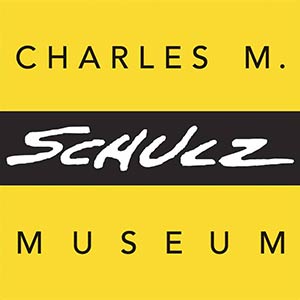
Museum Hours
Weekdays 11:00 am–5:00 pm*
Weekends 10:00 am–5:00 pm
*Closed Tuesdays
By the mid-1950s, the recognition of Charles Schulz and the Peanuts comic strip was evident not just from the increasing number of newspaper subscribers and the honor of the Reuben award, but also from the amount of fan mail pouring through the mail slot. At this time, fans, newspaper editors, librarians, and many others, wrote to the syndicate requesting original comic strips, suggesting ideas for the strip, or requesting licensing relationships. Fans were sent original strips when requested, unless the requested strip was already sent to someone else first, in which case another strip was sent instead. In some of the correspondence, fans requested to purchase strips, but they were never sold; only given away until the syndicate began to cease this practice by the early 1960s. It was during this period that Schulz took a bit of advice from his fan mail and cut out the unpopular Charlotte Braun from the strip. The letter Schulz sent in response to this is now known as “The Ax” and is preserved at the Library of Congress.
While the comic strip typically wasn’t seen as a fine art form to those in the art world or the general public, requests to exhibit Schulz’s original strips in gallery settings began to arrive by the late 1950s. In the fall of 1957, an exhibition of Peanuts originals was requested to be displayed at the Rhode Island School of Design (RISD) gallery. Another exhibit was held at University of Minnesota in 1958. Also in 1958, Yale University’s student newspaper bestowed Charles Schulz with the honor of “Humorist of the Year” and he attended a book signing near the school to thank his fans. Furthermore, many high schools around the United States began to use Peanuts drawings in their yearbooks, usually drawn by the school’s students, and sometimes with Schulz’s approval as indicated by the reprinted letters by him in the books.
Additionally, Schulz began to create other, non-Peanuts single panel comics for the Church of God publication Youth. While these weren’t entirely sacred in their message, they do exhibit some of Schulz’s religious beliefs at the time. He had first become acquainted with members of the Church of God after his mother died in 1943. After returning from his time in the army in 1945, Schulz began proselytizing with the group on the street corners of the Twin Cities. He soon grew weary of this practice, though he remained involved with the church and supported them in other ways throughout his life.

Weekdays 11:00 am–5:00 pm*
Weekends 10:00 am–5:00 pm
*Closed Tuesdays
| Cookie | Duration | Description |
|---|---|---|
| cookielawinfo-checkbox-analytics | 11 months | This cookie is set by GDPR Cookie Consent plugin. The cookie is used to store the user consent for the cookies in the category "Analytics". |
| cookielawinfo-checkbox-functional | 11 months | The cookie is set by GDPR cookie consent to record the user consent for the cookies in the category "Functional". |
| cookielawinfo-checkbox-necessary | 11 months | This cookie is set by GDPR Cookie Consent plugin. The cookies is used to store the user consent for the cookies in the category "Necessary". |
| cookielawinfo-checkbox-others | 11 months | This cookie is set by GDPR Cookie Consent plugin. The cookie is used to store the user consent for the cookies in the category "Other. |
| cookielawinfo-checkbox-performance | 11 months | This cookie is set by GDPR Cookie Consent plugin. The cookie is used to store the user consent for the cookies in the category "Performance". |
| viewed_cookie_policy | 11 months | The cookie is set by the GDPR Cookie Consent plugin and is used to store whether or not user has consented to the use of cookies. It does not store any personal data. |
